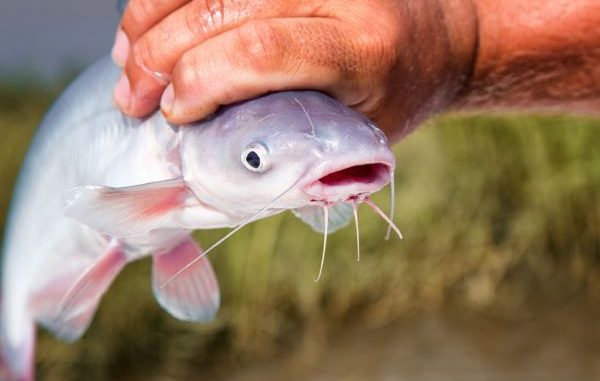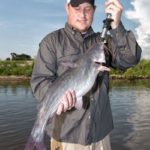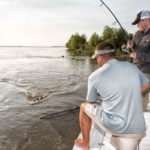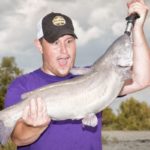
While most folks head down Plaquemines Parish’s Highway 23 anticipating hot saltwater fishing, this Baton Rouge sous chef is soaking bait for big catfish that are easy pickings because they rarely see a bait.
Aaron Langlois has an internal alarm clock set by his ancestors through Canada all the way back to France.
But rather than an irritating ring or bothersome buzz, Langlois’ internal alarm clock plays a little Cajun tune that lets him know when the catfish are biting.
That\’s when he finds himself irresistibly drawn to the same Mississippi River through which his ancestors traversed.
“It blows my mind to think that I get to fish in the same river they came up in,” Langlois told me after I arrived at Delta Marina in Empire 30 minutes after our scheduled 5:30 meeting time.
See, my own internal alarm clock was busted, and my supposedly technologically advanced alarm clock failed miserably.
Making sure my iPhone alarm was set correctly for 3 a.m., I fell asleep for what I knew would be only four hours.
I woke up seven minutes later than my planned departure time of 3:30.
At least my phone was competent enough to send my text that I would be 30 minutes late.
“Don’t worry,” Langlois responded. “These catfish helped lay the foundation of our survival hundreds of years ago. They ain’t going anywhere.”
A self-professed simple men, Langlois and his fishing buddy Joseph Bordelon don\’t need a lot of equipment to go fishing.
In fact, even though Capt. Lane Zimmer with Phil Robichaux Fishing Charters out of Lafitte generously volunteered to trade a little speckled trout slime on his bay boat for a little catfish slime, they would rather fish from the bank.
“We don’t need a lot of stuff to enjoy fishing where we live and put a little supper on the table,” the sous chef at Restaurant IPO in Baton Rouge continued while we waited for a commercial boat at the Empire lock, “but Capt. Lane’s boat will help us get a better look at some of these spots today.”
While locking through, Langlois explained that his internal alarm that plays the Cajun tune goes off any time he sees the Mississippi River start to fall.
Most recently, he noticed that the LouisianaSportsman.com flow charts showed a drop of 100,000 cubic feet per second at the Vicksburg gauge.
“Every day I check those charts,” Langlois noted, “and when I see that kind of drop at Vicksburg, I know that the fall is coming downriver. And as long as the North doesn’t get much more rain, the river is going to keep dropping down here.”
With the river still a little high and rolling, we pulled up to the west bank of the river near the end of an old boat ramp hardly a mile south of the lock.
The area was covered with rocks, and Langlois informed me that it was one of his and Bourgeois’ favorite bank-fishing spots because of how far they can walk out on the rocks when the river comes down.
Although the Mississippi River was falling, it was still high, so Zimmer positioned his boat as close to the outer rock edge as he could while still being able to hold his boat in place with his dual Power-Poles.
That meant we weren’t going to be able to reach the far side of the rocks — a spot Langlois dubbed the playground — so we were going to have to contend with fishing on top of the rocks.
Zimmer thought rigging up some sliding corks might help. Two had ½-ounce sinkers, and two had 1-ounce weights. The other two poles were rigged with bottom rigs complete with 1 ½-ounce lead.
While Langlois and Bordelon watched their sliding corks slip by in the current, my son grabbed one of the bottom rigs and heaved it out into the swift current.
“Dad, I\’m hung,” he told me moments later, but a quick glance at his loaded-up rod tip made me think he was hung on a big catfish rather than a rock.
He realized it just about the same time I did and perfectly followed Capt. Zimmer’s advice to reel rather than set the hook because he had rigged all our poles with circle hooks.
Bottom rigs quickly replaced sliding corks — everybody wanted to get in on the action. That’s when Langlois told us about how many sinkers he and Bordelon recently lost.
“The best way to deal with hang-ups is to have plenty of tackle,” he quipped as Zimmer began tying a new bottom rig to replace the one Langlois had just broke off. “With the water still up like this, we went through about 40 sinkers a couple days ago fishing this spot from the bank.”
All we could do was deal with the hang-ups if we wanted to catch fish. However, before too long, Zimmer said his tackle supply was running so low that we should look for a new spot that wouldn’t scarf down so many sinkers.
As we pulled in all poles in preparation for a move to the east side of the river, Langlois explained that all these hang-ups go away for the most part, especially when fishing from the bank, when the river finally falls out.
“From the bank, the low water allows us to walk out into the river a little bit farther,” he said. “When it drops out, we can actually stand on the rocks that were hanging us up and make long casts out to that big drop where it goes from 10 feet down to 40 feet in a matter of a 10-foot distance.”
Our second spot was a sandbar at the mouth of a pipeline crossing cut, but it was full of small catfish that Langlois didn’t want to deal with.
We moved farther downriver to fish behind a small island on the east side, where we landed some good, medium-sized cats, but neither Langlois nor Bordelon could get our first spot out of their minds.
“However many sinkers we have left, we need to go back to the first spot and risk losing them to catch some of those bigger catfish,” Langlois proclaimed.
Only this time, Zimmer positioned his boat in the eddy behind the rocky, abandoned boat ramp where he thought we might be able to fish without constantly having to keep tying on new bottom rigs.
Despite the roiling water, Langlois hooked up and landed the largest catfish of the day. It was an exclamation mark on the kind of catfishing action he finds from Baton Rouge down to Buras.
As we waited for the lock to open for our return to Delta Marina, Langlois told me he grew up right across from Dutchtown High School in Prairieville and spent a lot of time honing his catfishing techniques at Darrow just downriver from Geismer.
“There is some good bank fishing there,” he said. “We tear them up there, but you’ve got to get there early to get a spot before everybody else.
“Joseph\’s dad helped us get on this spot down here at Empire; it’s really good down here because I think these fish are pretty much left alone.”
Reasoning that most folks drive down Highway 23 from New Orleans to Venice with speckled trout and redfish in mind, Langlois feels the population of channel cats, blue cats and sometimes flatheads go unmolested.
“We mainly catch channel cats that cruise the rock ledge looking for a scent,” Langlois explained as Zimmer gingerly bumped his boat against the dock. “If they smell something, they move up there and eat it.
“Sometimes we catch some blues — and maybe a flathead or two — but I’ve found the channel cats tend to school up a lot more than the blues.”
In general, the channel cats don’t stick in one spot like the blues and flatheads. That’s why Langlois and Bordelon aren’t too quick to abandon a spot.
They bide their time catching a blue or two in the slower eddies. But when the channel cats move in, Langlois said it’s every pole down when they decide to swim by and eat.
Anglers can expect this kind of action up and down the Mississippi River until the water comes back up in the winter.
In the meantime, Langlois backs off the catfish come early September.
“It\’s not that the fish quit biting,” he said with a wry smile, “but that’s when the teal start flying.”
That\’s also the time his internal alarm clock starts sounding a lot more like a shotgun blast.
No rest for this Louisiana sportsman.





